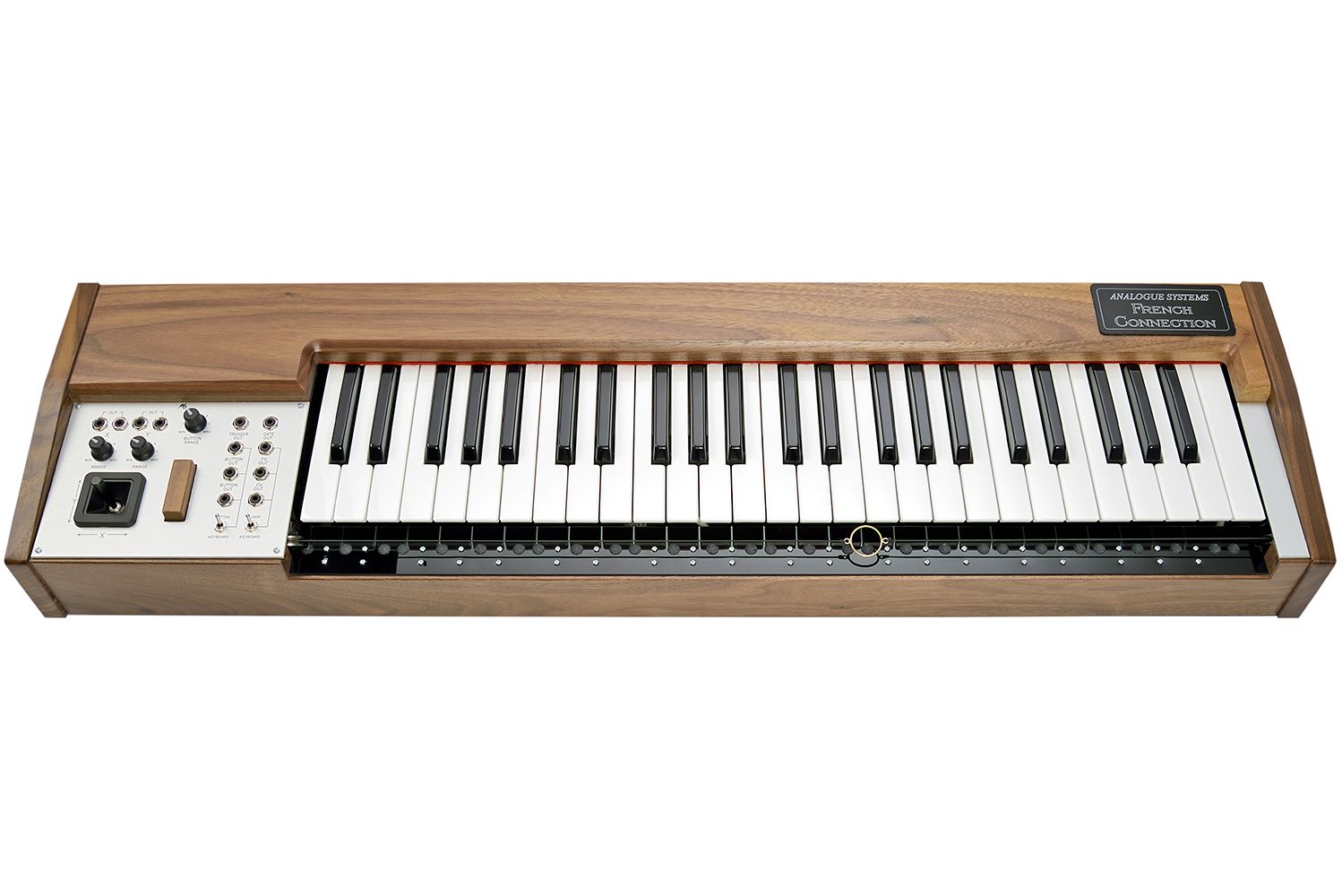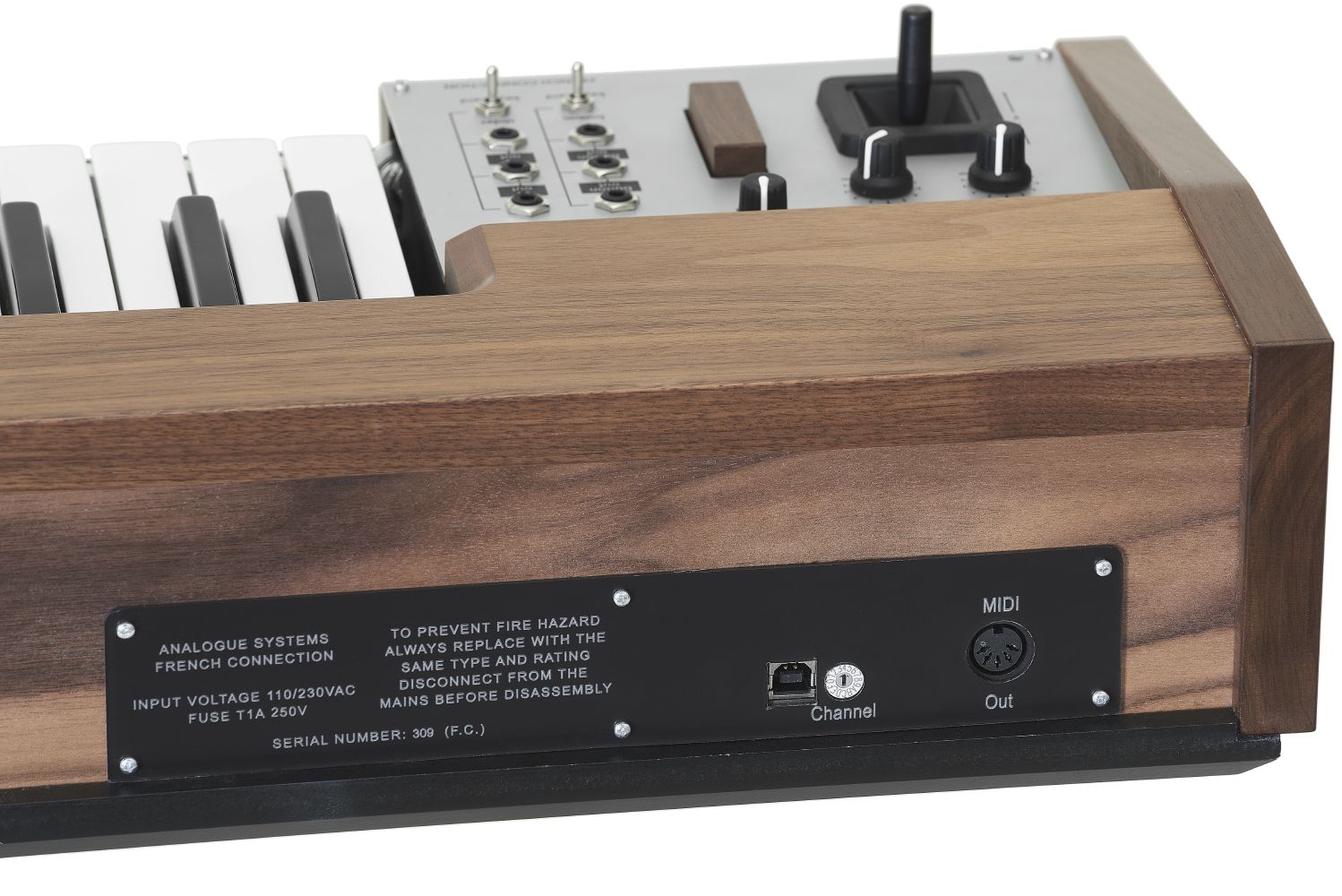Analogue Systems
The French Connection Mk2
Based upon the Ondes Martenot the French Connection is a unique controller for virtuoso Performance. By placing a finger through the ring suspended below the physical keyboard.
The player can smoothly glide between notes by moving the playing hand from left to right and create natural vibrato in the process. Theremin effects are easily obtained by connecting.
One of the cv outputs to an external VCO with sine wave output.
Based upon the Ondes Martenot the French Connection is a unique keyboard and perfomance controller.
The French Connenction totally adopts the control mechanisms of the Ondes Martenot. Instead of sound generators it offers several CV, Gate and Trigger outputs to control modular synthesizers.
By placing a finger through the ring suspended below the physical keyboard, the player can glide smoothly between notes by moving the playing hand from left to right, creating a very natural vibrato in the process, while a pressure resistant wooden button offers great control of the amplitude. A VCO and VCA is basically all it takes to recreate a sound similar to the Ondes Martenot. But of course the CVs the Fench Connection is supplying can be routed to any other parameter in a modular synthesizer as well.
Additionally there's a joystick to offer even more control and the 49-note keyboard also adds CV/Gate and Trigger outputs.
The new version features MIDI and USB connections.
INTRODUCTION
The Ondes Martenot was developed by Maurice Martenot. A radio operator during the First World War, he noticed how the interaction of two pieces of similarly tuned electrical equipment could give rise to potentially musical oscillations. After the war, Martenot began his research into the musical applications of electricity and the possibilities offered by allowing high frequency oscillators to interfere with one another. However, much of his work over the ensuing nine years is clouded in mystery because he did not unveil his eponymously named instrument until May 1928.
The first Ondes Martenot had a conventional keyboard but, more importantly, a wire that stretched the length of the keyboard, and which you moved from side to side using a little ring that you slipped over the index finger of your right hand. If you moved the ring to the right, the pitch of the sound produced by the instrument increased; if you moved the ring to the left, the pitch dropped. Had this been all the control offered by the Ondes Martenot, it would not have been a particularly musical instrument. However,there was a second control that allowed you to articulate notes using your left hand. The combination of the two made it possible to determine both the pitch and the amplitude of a note, and the result was not unlike a human voice, or an instrument such as the ‘cello or violin.
The Ondes Martenot’s playing mechanism was novel, but its playback system was amazing. There were three parts to this. The first was called the "principal", and this was a straightforward loudspeaker. The second was the "resonance diffuser". Called the "Palme", its resonant chamber and twelve tuned stringsresonated in sympathy with the notes played by the performer, creating complex tones in the same way as some Eastern string instruments. The third part was a second diffuser called the "Metallique". This was, in essence, a traditional loudspeaker, but with the cone replaced by a metallic plate similar to a cymbal or gong. This added a distinctive metallic timbre to the sound.
Martenot’s instrument was a marvel, and proved to be a huge success, so he proceeded to design and build a number of variations. One of these allowed you to wiggle the keys themselves from side to side to create natural vibrato. There was also a smaller version called the Ondioline. But whatever else changed, one thing remained constant... there was always a wire with a ring that controlled the pitch of the sound.
On a well-adjusted Ondes Martenot, the semitone positions of the ring correspond to the keys on the keyboard behind it. This makes it much simpler to play than a Theremin. This fact was not lost on the composers of the day and several wrote music for it. Of these, the most famous were undoubtedly Ravel, Boulez, Messiaen, and (more recently) Maurice Jarre, but many others have contributed to a repertoire of more than 1000 classical works that feature the instrument.
In use :
The French Connection offers the expressive potential of the Ondes Martenot coupled to the huge resources of the analogue synthesiser. Controlling sounds is completely intuitive and musical; the depressions and studs on the fingerboard make it simple to locate conventional semitones, and the ring moves without any discontinuities or unevenness. With a little practice you will be able to articulate each note individually and smoothly using the amplitude "button", and create slides and vibrato without difficulty.
The control panel comprises three sections: the joystick, the amplitude Button, and the Controller Select Switches.
The Joystick
The joystick uses a high quality self-centring X/Y joystick mechanism that provides smooth responseacross its full range. (You can remove the internal springs to allow for non-centring action, if desired.) Itprovides two outputs for each CV generated.
RANGE
At its far left extreme or its lowest point, the joystick will generate a voltage of -10V at the X outputs or Y outputs (respectively). At its far right extreme or its highest point, the joystick will generate a voltage of+10V at the X outputs or Y outputs (respectively). The RANGE controls reduce the maximum output CVs to approximately 0V at their MIN settings, while passing the full ±10V ranges when set to MAX.
The Button
If left untouched, this sits in its uppermost position, and generates a CV of 0V. As you depress the Button,the CV rises progressively to a maximum of approximately +10V.
RANGE
The RANGE offers fine control, reducing the output CV of the Button to 0V at its MIN settings, while passing the full ±10V range when set to MAX.
Controller Select Switches
The first of these determines whether the pitch CV is controlled by the keyboard or by the wire controller.The second determines whether the keyboard produces a conventional trigger and gate, or whether the Button produces an amplitude CV.
There are four switch combinations:
BUTTON + SLIDER
Imitates the Ondes Martenot
KEYBOARD + KEYBOARD
Acts as a conventional CV+Trigger+Gate monosynth keyboard
KEYBOARD + SLIDER
Control the pitch of the sound using the wire controller, but trigger envelopes using the keyboard.
BUTTON + KEYBOARD
Play the pitch of the sound conventionally using the keyboard; articulate notes using the button.
Outputs
Joystick
Each axis offer dual 3.5mm outputs with a maximum range of ±10V. Each pair carries identical signals with maximum operational values determined by the jostick's RANGE controls.
Keyboard Gate / Button
Three 3.5mm outputs offer a maximum range of +10V.
Keyboard CV / Slider
Three 3.5mm sockets output 0V to +3.89V. This represents the 48-key range C-B.
Gate
An additional +10V Gate is provided in Keyboard mode.
Trigger
A +10V Trigger is provided in Keyboard mode.
Note: The power connector for the French Connection is to the right of the keyboard rather than to the rear so that you can place the unit flush against Analogue Systems synthesisers such as the RS-8000 and RS-8500.
Note: to calibrate, slide the ring back and forth a few times, from minimum to maximum position.

